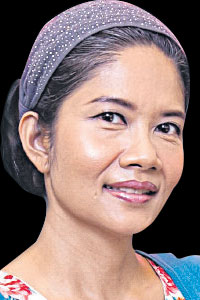This "Urban October" should have us all rethinking the future of Bangkok.
For this month, the United Nations has prioritised encouraging the international community towards a new urban agenda. Activities kicked off yesterday with World Habitat Day, which falls on the first Monday of October, with this year's focus coming under the theme, "Public Spaces For All".
The four weeks of activities will culminate on Oct 31 and on another United Nations' flagship event marking World Cities Day. Likewise, its theme, "Designed To Live Together", encourages urbanites to ponder the concept of harmony, which depends on equality and sustainability.
As Bangkokians, we have become used to not having adequate public spaces, defined as areas that are accessible and enjoyable by all. These sorts of places include parks and playgrounds, as well as streets and pavements (Bangkok pedestrians can rarely find wide and decent pavements).
By 2030, one of the UN's long-term sustainable development goals aims to provide access to green and public spaces that are safe for women, children, seniors and people with disabilities.
It has been said that the number of Bangkok green areas are consistently ranked as one of the lowest in the world. There are a few, including Lumpini, Benjakiti, and Rama IX parks, but besides these, there are just smaller ones scattered around the city, many of which may not even be considered parks.
The cities' playgrounds, therefore, tend to be in shopping or lifestyle malls, with whole families, couples, and solitary strollers choosing to spend their recreational time there. Every weekend, this causes chaotic traffic jams.
Bangkok's notorious traffic is a daily affair though and is definitely one of the capital's biggest problems, worsened by a number of things, including construction of a railway system happening in various spots around the city and Thon Buri.
For instance, motorists have had to bear with the closing of the flyover at Kasetsart University since Sept 12. Its demolition was required for the construction of the Green Line electric railway connecting Mo Chit to Khu Khot in Pathum Thani province.
Of course, it will take several years before commuters can conveniently take that train ride. However, at least people in that part of the city will soon have an efficient public transport system, whereas, for me living in Bangkapi, I will have to wait much longer for the materialisation of MRTA's Yellow Line (Lat Phrao-Samrong) which will probably be completed by the time I retire.
A better public transport system is on the top of my wish list for a better Bangkok. There just has never been an integrated planning of the public transport system like in other major cities around the world.
Living here for almost half a century, I have to say that I have never noticed much attention being paid to city planning, or any solid strategies laid for population growth and urbanisation. Long-term planning as well as any kind of futuristic urban design has also always seen to be out of the question.
Planned urbanisation, according to the UN, generates employment and wealth while fostering diversity and cohesion between different classes, cultures, ethnicities and religions -- a goal supported by the "Designed To Live Together" ideology.
This is even more challenging with the increasing population within Bangkok's limited spaces, infrastructure and financial resources in how we can build a "Better City, Better Life" (slogan for World Cities Day 2015).
The ideal urban design aims to promote togetherness and social harmony by building integrated neighbourhoods with the planning of residential areas that bring people of different backgrounds together, while sharing a sustainable use of resources.
The design also considers participation in uniting people around shared goals and visions, while promoting equality to services, jobs and opportunities.
Related to the "Public Spaces For All" concept, it also addresses the designs of streets, pedestrian spaces, parks and playgrounds to promote a vibrant civic life.
Again, Bangkok is lacking in the design of urban spaces, whereas other Asian cities, such as Singapore and Taipei, have been transformed from commercially-oriented metropolises to cities with a vibrant well-designed urban environment.
What has definitely changed about Bangkok in recent years is the mushrooming of condominiums, particularly along the BTS and MRT lines, while we are also anticipating the opening of more shopping malls. For example, after CentralPlaza WestGate, I'm looking forward to CentralFestival East Ville coming to my neighbourhood. Hopefully, this Urban October month will urge a more progressive mindset for a holistic approach of a better tomorrow for Bangkok.
Kanokporn Chanasongkram is a feature writer of the Life section of the Bangkok Post.
